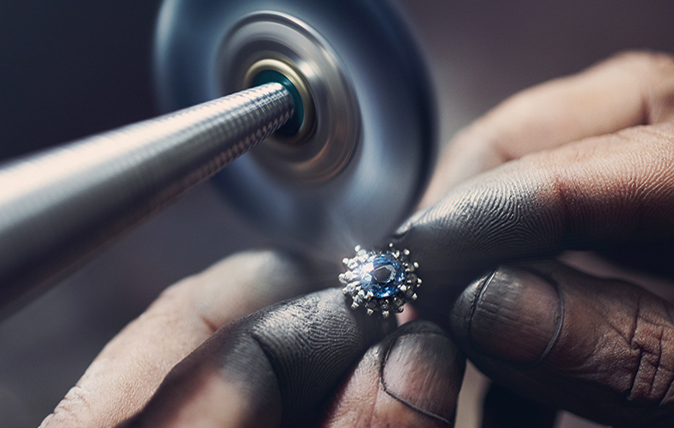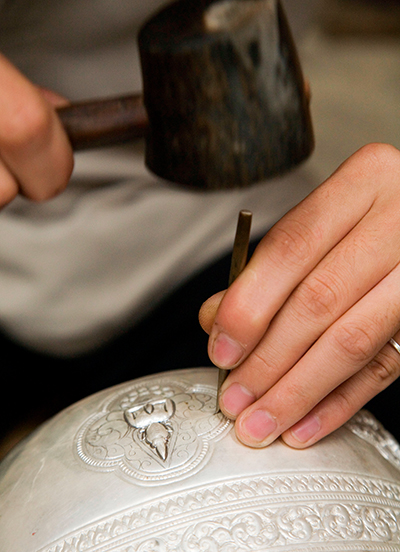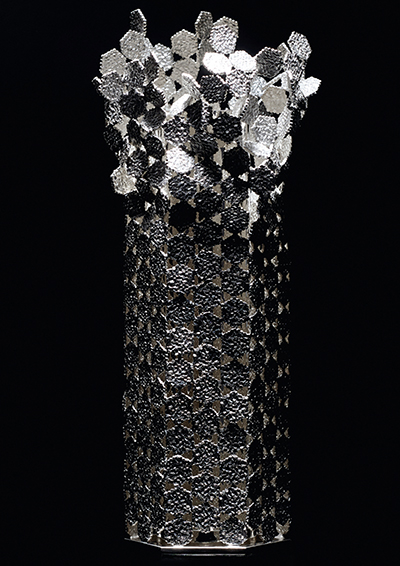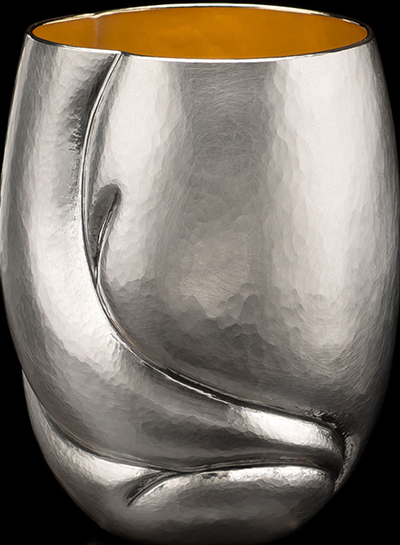The beauty of silver
The ancient art of silversmithing is undergoing something of a renaissance, as an arresting new display at the V&A shows


By Matthew Dennison
‘Silver is sensuous, seductive and elegant,’ eulogises the curator of an arresting new silversmithing display at the V&A, Corinne Julius. ‘And, for the past 20 years, Britain has been at the forefront of contemporary silversmithing globally.’
Miss Julius’s exhibition, ‘Silver Speaks: Idea to Object’, celebrates the creative stages of silversmithing. ‘It traces how a work in silver is brought into existence from the inspiration, through sketches, models, material experimentation and construction processes, to the final piece,’ she explains, adding that it includes just 18 exquisite works by leading British makers. ‘I wanted to show the very different ways that contemporary silversmiths utilise this magical material and to encourage visitors to understand how silversmiths use a combination of head, heart and hands to create their designs.’
Each featured maker is a member of Contemporary British Silversmiths (CBS), the craft’s leading organisation, which this year celebrates its 20th anniversary.
The V&A’s display is one of a number of events taking place in 2016 under the ‘Silver Speaks’ umbrella. All share the same basic aim—‘of finding new audiences for silver and a new generation of collectors, who have previously discounted silver because of its association with Granny’s teapot,’ according to CBS chair Rauni Higson.

Silver being transformed from its raw state into ‘something majestic
The focus of ‘Idea to Object’ is two-fold. The display showcases the highest standards of craftsmanship and design and demonstrates the extent to which this versatile and handsome material transcends traditional views of silver as a luxury material for dining rooms and trophy cabinets.
Sign up for the Country Life Newsletter
Exquisite houses, the beauty of Nature, and how to get the most from your life, straight to your inbox.
Each featured maker, Miss Julius points out, ‘created a completely new piece of work, which developed their skill base as a silversmith and stretched them intellectually’. Exhibits include functional and decorative pieces, with several such as Miss Higson’s sensuous Brushstroke, which is simultaneously a shallow bowl and a work of sculpture that demonstrates in sinuous form the contrast between soft, undulating curves and brightly polished sharp edges.
Every piece displays its maker’s delight in the properties of silver as a material. In the majority of cases, the influence of historic silversmithing— Britain’s long and distinguished heritage of creating beautiful silver —is felt only as an encouragement to continue to explore and expand the possibilities of the medium
‘Silversmithing is a process of transformation,’ silversmith Angela Cook tells me. ‘The raw material is beautiful in itself, but cut, filed and shaped, it becomes something majestic.’ She describes her own five-piece Pillow cutlery set, made using a number of construction techniques, as ‘a labour of love’, a design that combines elegance with ergonomic considerations. Makers agree that, at this level, British silver is presently enjoying a renaissance (by contrast, the cutlery industry generally continues to experience a decline, influenced by changing lifestyles and informal eating habits).

New collectors are attracted to the work of CBS’s members as examples of exciting modern design and painstaking standards of craftsmanship, in some cases, such as Hamish Dobbie’s Growth Vase (right), assisted by new technologies such as 3D printing or the cutting and folding techniques explored in their pieces by Rebecca De Quin and Mary Ann Simmons
Student silversmiths from across the globe, especially the Chinese, currently travel to Britain to develop their skills and there is a growing acknowledgement, according to Miss Julius, that silver—once associated with ‘wealth, privilege, status and all that was stuffy and “class-ist”’—has successfully reinvented itself as ‘a medium for thinking and for the expression of ideas and stories, a new artistic language’.
Artistry is at the fore in the V&A’s display. Juliette Bigley’s Two Bowls and Kevin Gray’s Animus are purely sculptural pieces; other craftspeople have drawn inspiration from Nature and developed sculptural, but functional, objects.
The extraordinary hexagonal rock formations of Fingal’s Cave inspired Mr Dobbie’s Growth Vase and Miss Higson’s Brushstroke reflects in solid form the dramatic views from her studio window in North Wales. Abigail Brown’s ‘Boscawen- Un’ Vessel arose from her long-term interest in standing stones and the lichens that colonise them. In each case, the result is something forward-looking, handsome and unique.

Noticeable in the current display is the use several makers have made of unpolished areas of silver, part of a wider rejection of the idea that silver is first and foremost a symbol of luxury. This kind of matte finish, Miss Julius comments, ‘has a delicate, moonlight, reflective quality and reduces the association of silver with bling’.
This wasn’t always the case, of course. From Romano-British silver pieces such as the Great Dish of the Mildenhall Treasure, made in about AD350, to 17th-century silver wine cisterns and the sparkling silver and silver-gilt services made for George IV by Rundell, Bridge and Rundell, British silver has revelled in the sumptuous possibilities of this malleable, highly reflective material.
Such was once the value of silver as a material that accounts from the early medieval period indicate that noble families used silver as an alternative ‘banking’ system, storing their wealth in silver objects, which were afterwards melted down to release cash. The popularity of silver led to regional centres of silversmithing nationwide. In time, regional assay offices followed.
Here, silver was ‘assayed’ or tested to guarantee it satisfied the legal standard requirements for sterling silver, as established by Henry II: a silver alloy of 92.5% silver and 7.5% copper. Assay offices continue to test British silver and assay marks remain one of the four hallmarks visible on British silver (see box), although, today, only four working assay offices remain in the kingdom, in London, Birmingham, Sheffield and Edinburgh.
On its first working day—August 31, 1773—the Birmingham Assay Office hallmarked some 200 pieces of silver; in 2002, a bumper year, the Birmingham office struck some 12 million hallmarks.
‘Silver has phenomenal properties. I like the preciousness of the material and its amazing lustre,’ enthuses Mr Dobbie. ‘Today’s technology allows the creation of more interesting shapes that wouldn’t have been possible even 20 years ago.
It’s capable of a variety of different finishes and, through silver, it’s possible to change the public’s view of metalwork.’ As visitors to ‘Idea to Object’ will discover, such lofty claims are handsomely substantiated.
The programme of events included in ‘Silver Speaks’, which runs until January 31, 2017, has been organized by Contemporary British Silversmiths. For further information, visit www.silverspeaks.co.uk
What is in a hallmark?
Hallmarks guarantee the authenticity of British silver and also provide information about its place and date of manufacture and the identity of its maker. Typically, pieces are stamped with four hallmarks (although pieces made before 1890 may feature a fifth mark, the sovereign’s head in profile, struck to certify that the maker had paid the necessary tax or duty at the time of assay).
These marks are:
** The sterling mark, introduced by Edward II in 1300 as proof that a piece had been tested by an assay office and met the minimum silver requirement of sterling silver, 92.5%. The main assay offices of London, Birmingham and Sheffield used the symbol of a lion passant ** The maker’s mark, from 1363, identifying the piece’s maker or manufacturer ** The assay-office mark, from 1423, indicating which assay office had guaranteed the piece (in the 19th century, there were 20 assay offices across Britain): a different symbol represented each town, for example, a lion’s head full face for London ** A date mark: a letter of the alphabet used for each 12-month period, which ran from May to May. Letters used differed between offices
-
 About time: The fastest and slowest moving housing markets revealed
About time: The fastest and slowest moving housing markets revealedNew research by Zoopla has shown where it's easy to sell and where it will take quite a while to find a buyer.
By Annabel Dixon
-
 Betty is the first dog to scale all of Scotland’s hundreds of mountains and hills
Betty is the first dog to scale all of Scotland’s hundreds of mountains and hillsFewer than 100 people have ever completed Betty's ‘full house’ of Scottish summits — and she was fuelled by more than 800 hard boiled eggs.
By Annunciata Elwes